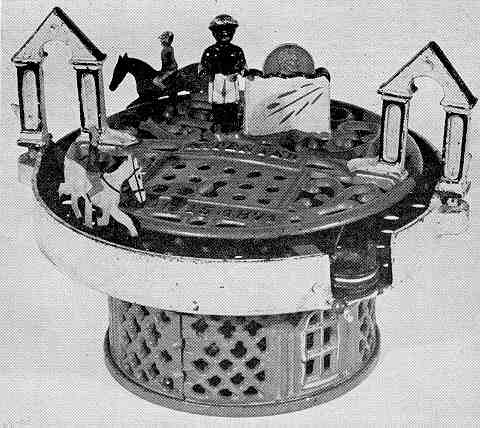Horse Race Bank
by F.H. Griffith - HOBBIES Magazine - March, 1959

The designer of the earliest known dated cast iron mechanical bank comes to the fore as we reach the present point in the numerical classification articles. The designer is John Hall and the earliest known dated cast iron mechanical bank is the Halls Excelsior. He also designed the Horse Race Bank which is our choice as No. 72 in the series.
The Horse Race Bank was patented by John Hall August 15, 1871, just two years after the Halls Excelsior which was patented December 21, 1869. The Horse Race is the most outstanding mechanical bank designed by Hall and to today’s collector it is the rarest and most desirable of his banks. John Hall lived in Watertown, Mass., and all his mechanical banks, including the Horse Race, were made by the J. & E. Stevens Company of Cromwell, Conn. Apparently, he was completely absorbed with the idea that the weight of a coin should cause the action to occur and this is borne out by the fact that all his mechanical banks operate on this principle. Three of Hall’s banks undoubtedly sold in greater quantities and enjoyed a longer period of popularity than any of the other mechanical banks. These were the Excelsior, Tammany, and Lilliput. They are among the earliest known mechanical banks, but today they are still relatively common. This, of course, is due to the fact they were made in larger quantities over a number of years.
The Horse Race shown is in excellent original condition and has been in the writer’s collection for some years. It was purchased by the writer in an antique shop in Worcester, Mass. The paint is exceptionally fine and the colors are as follows: The lattice base and scroll work top are bright red; the circular rim of the top is white, and the two arches are also white with blue outlining. The colored boy is black with red striped white trunks and a red striped white rimmed turban. Beside the colored boy is a white rectangular box-like coin slot with blue and red decorations. One horse is brown and the rider has a red shirt and yellow trousers. The other horse is white and the rider has a blue shirt and red trousers. The reins, the mane, and the tail of each horse is done in black. On the scroll work top appears the wording "Patented August 15, 1871," and this is painted blue. The archways on the round base are painted yellow and the word "Bank" over each archway is in blue.
The Horse Race Bank when originally sold through toy stores, jobbers, and other outlets came with printed instructions as to its operation. These instructions were on a rectangular piece of paper that fitted in a space provided on the top of the bank. This section, which has round perforations, can be seen in the picture between the word "Patented" and the date.
The operation of the bank is unique and quite interesting. The string with the small bead on the end is first pulled out and the pulley like wheel with the lug revolves as this is done. This pulley can be seen in the picture. As the operator pulls the string another string fastened to a long flat spring inside the bank is wound onto the pulley putting tension on the spring. A lever snaps into place holding the pulley with tension on the spring and this lever extends under the section where the coin is dropped. Both horses are then placed into position beside a star on the base which is located to the right of the colored boy. When the horses are placed in this position the extended balanced arm section of each horse is located just to the front of the lug on the pulley. A coin is then dropped in the provided slot as shown in the picture. The weight of the coin trips the lever and activates the spring which causes the pulley to snap around. The lug on the pulley hits the extended arms and causes the horses to speed around the track at a lively pace.
The Horse Race Bank has excellent action and the fact that the weight of the coin causes the action is a very desirable feature. In closing it is well to mention that the bank is entirely cast iron with the exception of the tin horses and their respective arm extensions. It is a hard bank to find in good complete original condition and a favorite among the collectors of mechanical banks.
